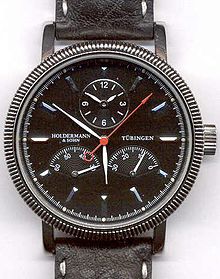Retrograde clock

Retrograph, Holdermann & Sohn, Tübingen
A retrograde clock , also known as a retrograde clock, runs counterclockwise . Such clockworks are offered for special clocks with an attached mechanism (e.g. shadow clocks) or for fun clocks. Clocks with Hebrew lettering are or were retrograde, according to the reading direction of Hebrew.
Well-known watches with retrograde display elements include the Timex Yacht Racer regatta watch , the Swatch Irony Retrograde with a counterclockwise stopper, and the Longines Master Collection Retrograde with three (day, date, 2nd time zone) and four (day, date, second, 2nd time zone) ) retrograde functions or the Maurice Lacroix Masterpiece Rétrograde with retrograde date hand.
For special functions such as B. Countdown or chronograph, there are also individual receding hands ( retrograde display as a complication ). In the case of a complication known as a retrograde display , a pointer showing the time or date moves over a segment of a circle (1 to 12 or 1 to 31) and jumps back to its starting position when it has reached the end of the segment scale.
Web links
Individual evidence
- ↑ Archived copy ( Memento of the original from March 4, 2016 in the Internet Archive ) Info: The archive link was inserted automatically and has not yet been checked. Please check the original and archive link according to the instructions and then remove this notice.
- ^ Helmut Kahlert , Richard Mühe , Gisbert L. Brunner , Christian Pfeiffer-Belli: wrist watches: 100 years of development history. Callwey, Munich 1983; 5th edition, ibid 1996, ISBN 3-7667-1241-1 , p. 505.
